Gender Inequality: A Study of Social Structures and Legal Impact
VerifiedAdded on 2023/06/12
|7
|1857
|429
Essay
AI Summary
This essay provides an overview of gender inequality, examining its historical roots, societal impact, and legal implications. It discusses how women have been historically marginalized and the role of cultural traditions and patriarchal structures in perpetuating this inequality. The essay also explores the evolution of women's rights movements and legal efforts to address gender disparities, including laws and policies aimed at promoting gender sensitivity. It further analyzes gender inequality in the workplace, highlighting issues such as job segregation and the underrepresentation of women in leadership positions. The essay concludes that while progress has been made, gender inequality remains a deeply entrenched phenomenon, requiring ongoing efforts to challenge societal norms and promote equal opportunities for all. Desklib offers this and many other solved assignments to aid students in their academic journey.
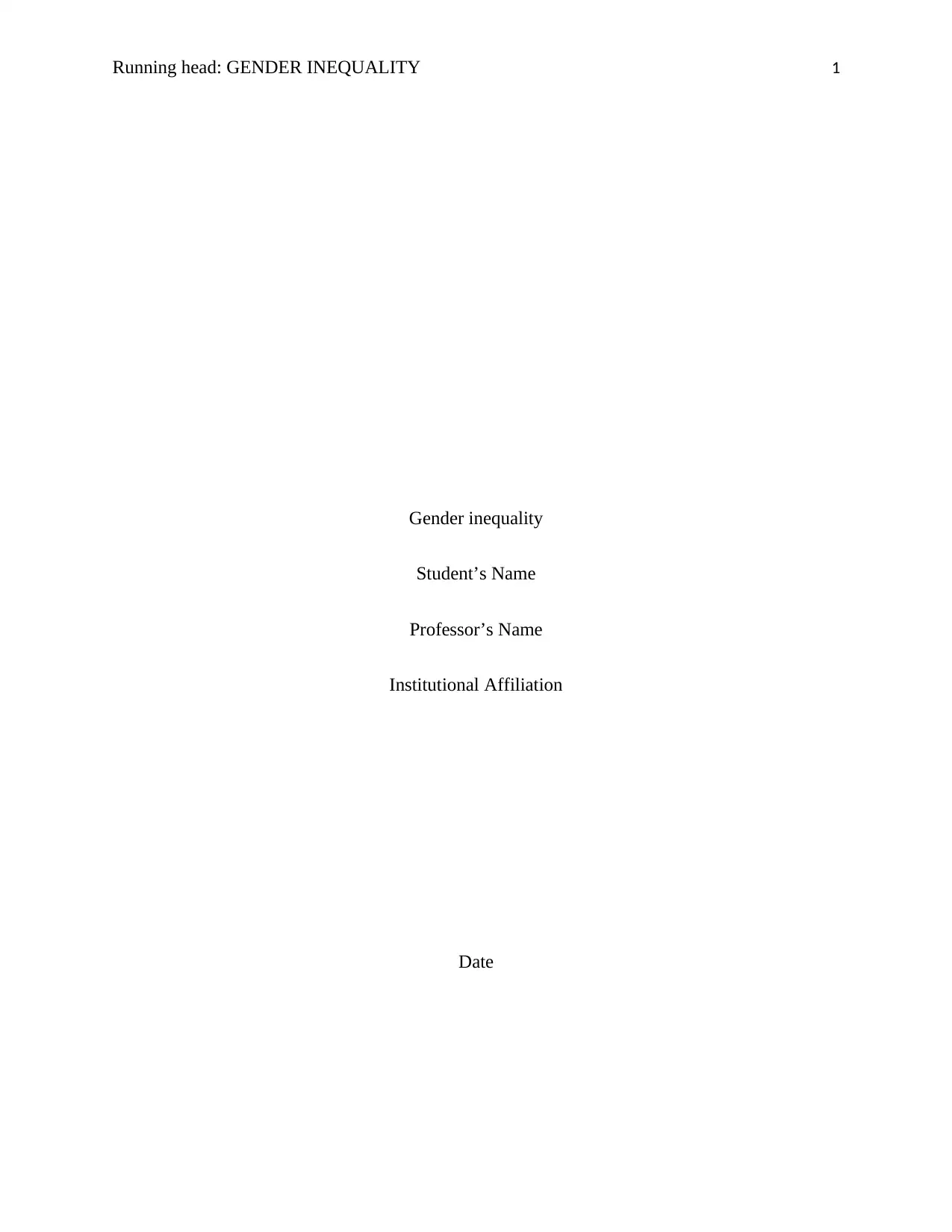
Running head: GENDER INEQUALITY 1
Gender inequality
Student’s Name
Professor’s Name
Institutional Affiliation
Date
Gender inequality
Student’s Name
Professor’s Name
Institutional Affiliation
Date
Paraphrase This Document
Need a fresh take? Get an instant paraphrase of this document with our AI Paraphraser
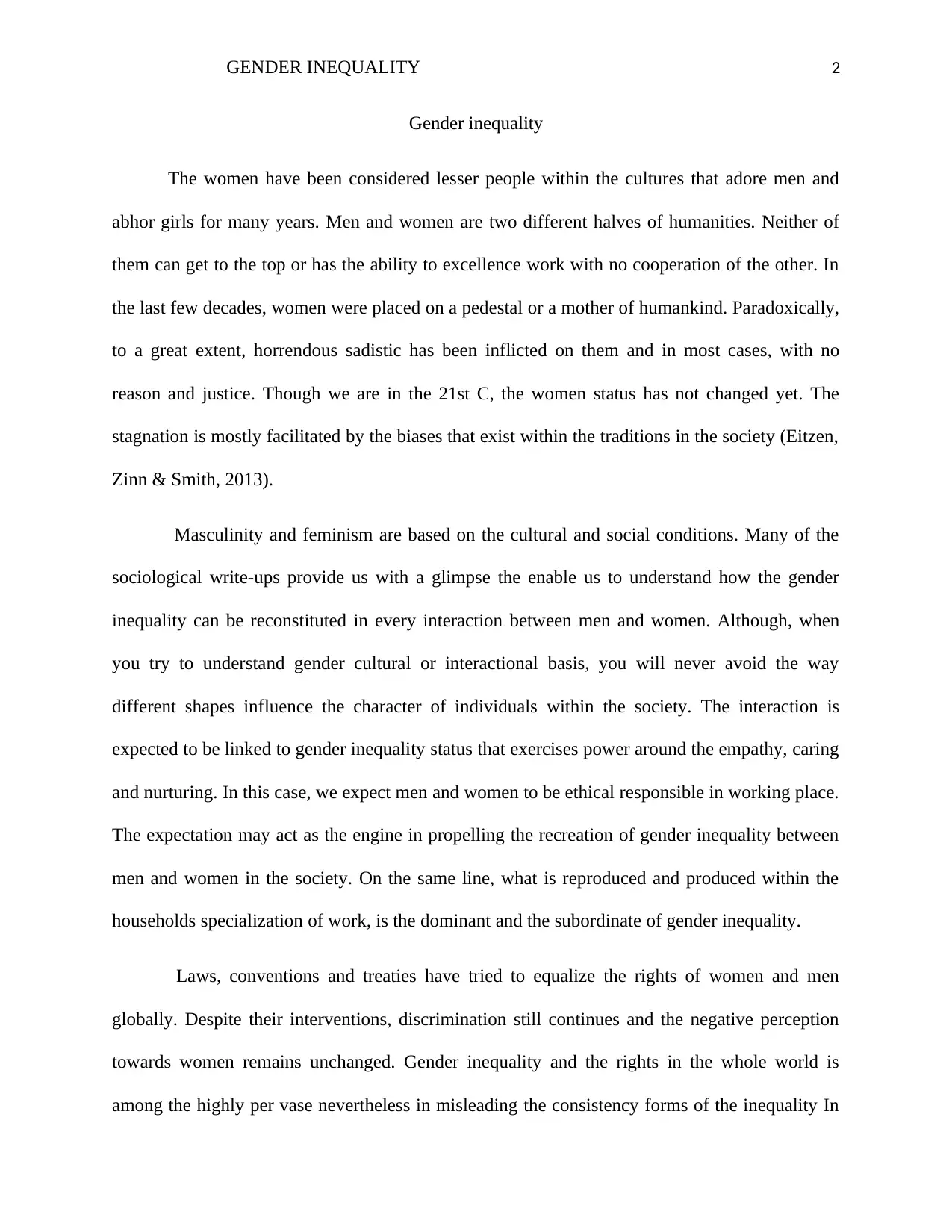
GENDER INEQUALITY 2
Gender inequality
The women have been considered lesser people within the cultures that adore men and
abhor girls for many years. Men and women are two different halves of humanities. Neither of
them can get to the top or has the ability to excellence work with no cooperation of the other. In
the last few decades, women were placed on a pedestal or a mother of humankind. Paradoxically,
to a great extent, horrendous sadistic has been inflicted on them and in most cases, with no
reason and justice. Though we are in the 21st C, the women status has not changed yet. The
stagnation is mostly facilitated by the biases that exist within the traditions in the society (Eitzen,
Zinn & Smith, 2013).
Masculinity and feminism are based on the cultural and social conditions. Many of the
sociological write-ups provide us with a glimpse the enable us to understand how the gender
inequality can be reconstituted in every interaction between men and women. Although, when
you try to understand gender cultural or interactional basis, you will never avoid the way
different shapes influence the character of individuals within the society. The interaction is
expected to be linked to gender inequality status that exercises power around the empathy, caring
and nurturing. In this case, we expect men and women to be ethical responsible in working place.
The expectation may act as the engine in propelling the recreation of gender inequality between
men and women in the society. On the same line, what is reproduced and produced within the
households specialization of work, is the dominant and the subordinate of gender inequality.
Laws, conventions and treaties have tried to equalize the rights of women and men
globally. Despite their interventions, discrimination still continues and the negative perception
towards women remains unchanged. Gender inequality and the rights in the whole world is
among the highly per vase nevertheless in misleading the consistency forms of the inequality In
Gender inequality
The women have been considered lesser people within the cultures that adore men and
abhor girls for many years. Men and women are two different halves of humanities. Neither of
them can get to the top or has the ability to excellence work with no cooperation of the other. In
the last few decades, women were placed on a pedestal or a mother of humankind. Paradoxically,
to a great extent, horrendous sadistic has been inflicted on them and in most cases, with no
reason and justice. Though we are in the 21st C, the women status has not changed yet. The
stagnation is mostly facilitated by the biases that exist within the traditions in the society (Eitzen,
Zinn & Smith, 2013).
Masculinity and feminism are based on the cultural and social conditions. Many of the
sociological write-ups provide us with a glimpse the enable us to understand how the gender
inequality can be reconstituted in every interaction between men and women. Although, when
you try to understand gender cultural or interactional basis, you will never avoid the way
different shapes influence the character of individuals within the society. The interaction is
expected to be linked to gender inequality status that exercises power around the empathy, caring
and nurturing. In this case, we expect men and women to be ethical responsible in working place.
The expectation may act as the engine in propelling the recreation of gender inequality between
men and women in the society. On the same line, what is reproduced and produced within the
households specialization of work, is the dominant and the subordinate of gender inequality.
Laws, conventions and treaties have tried to equalize the rights of women and men
globally. Despite their interventions, discrimination still continues and the negative perception
towards women remains unchanged. Gender inequality and the rights in the whole world is
among the highly per vase nevertheless in misleading the consistency forms of the inequality In
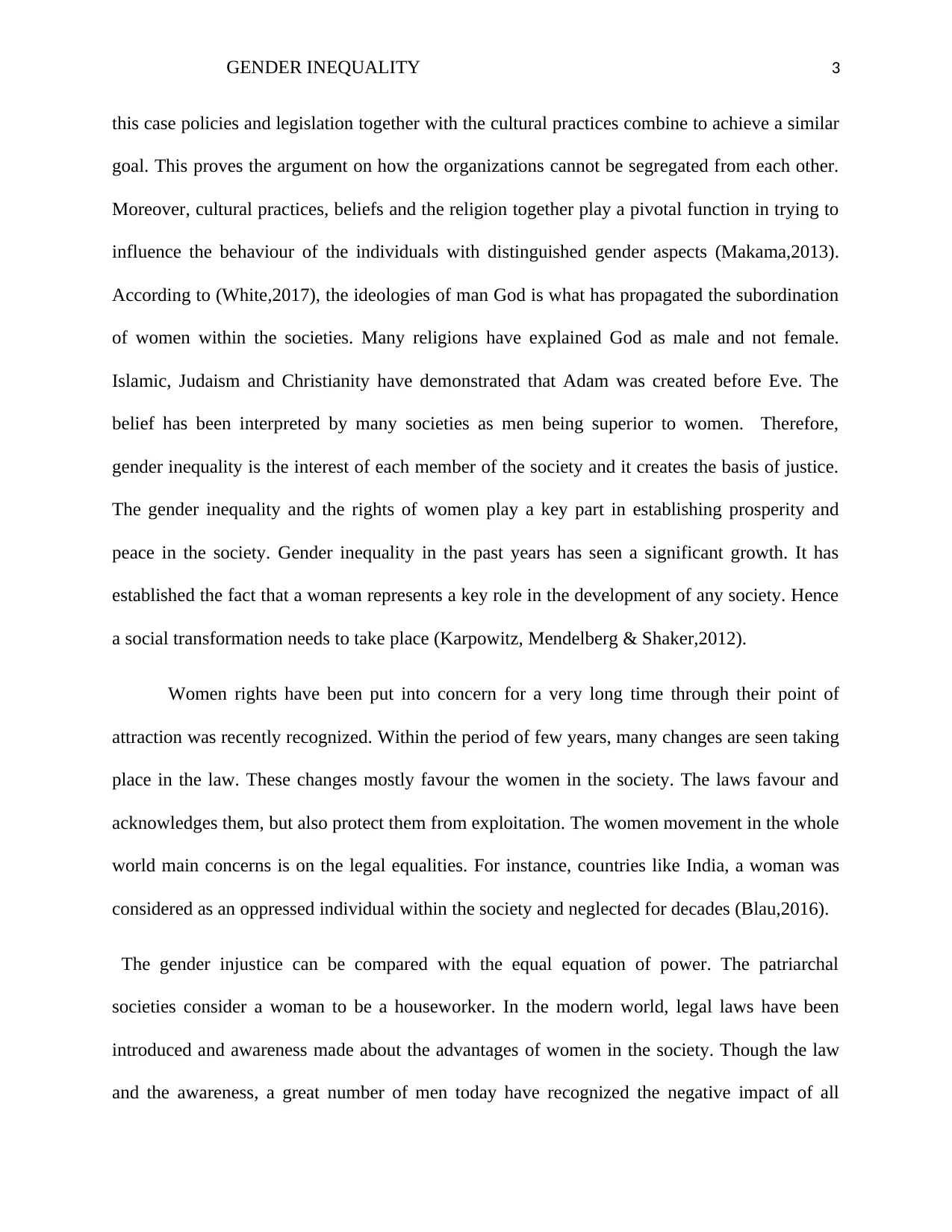
GENDER INEQUALITY 3
this case policies and legislation together with the cultural practices combine to achieve a similar
goal. This proves the argument on how the organizations cannot be segregated from each other.
Moreover, cultural practices, beliefs and the religion together play a pivotal function in trying to
influence the behaviour of the individuals with distinguished gender aspects (Makama,2013).
According to (White,2017), the ideologies of man God is what has propagated the subordination
of women within the societies. Many religions have explained God as male and not female.
Islamic, Judaism and Christianity have demonstrated that Adam was created before Eve. The
belief has been interpreted by many societies as men being superior to women. Therefore,
gender inequality is the interest of each member of the society and it creates the basis of justice.
The gender inequality and the rights of women play a key part in establishing prosperity and
peace in the society. Gender inequality in the past years has seen a significant growth. It has
established the fact that a woman represents a key role in the development of any society. Hence
a social transformation needs to take place (Karpowitz, Mendelberg & Shaker,2012).
Women rights have been put into concern for a very long time through their point of
attraction was recently recognized. Within the period of few years, many changes are seen taking
place in the law. These changes mostly favour the women in the society. The laws favour and
acknowledges them, but also protect them from exploitation. The women movement in the whole
world main concerns is on the legal equalities. For instance, countries like India, a woman was
considered as an oppressed individual within the society and neglected for decades (Blau,2016).
The gender injustice can be compared with the equal equation of power. The patriarchal
societies consider a woman to be a houseworker. In the modern world, legal laws have been
introduced and awareness made about the advantages of women in the society. Though the law
and the awareness, a great number of men today have recognized the negative impact of all
this case policies and legislation together with the cultural practices combine to achieve a similar
goal. This proves the argument on how the organizations cannot be segregated from each other.
Moreover, cultural practices, beliefs and the religion together play a pivotal function in trying to
influence the behaviour of the individuals with distinguished gender aspects (Makama,2013).
According to (White,2017), the ideologies of man God is what has propagated the subordination
of women within the societies. Many religions have explained God as male and not female.
Islamic, Judaism and Christianity have demonstrated that Adam was created before Eve. The
belief has been interpreted by many societies as men being superior to women. Therefore,
gender inequality is the interest of each member of the society and it creates the basis of justice.
The gender inequality and the rights of women play a key part in establishing prosperity and
peace in the society. Gender inequality in the past years has seen a significant growth. It has
established the fact that a woman represents a key role in the development of any society. Hence
a social transformation needs to take place (Karpowitz, Mendelberg & Shaker,2012).
Women rights have been put into concern for a very long time through their point of
attraction was recently recognized. Within the period of few years, many changes are seen taking
place in the law. These changes mostly favour the women in the society. The laws favour and
acknowledges them, but also protect them from exploitation. The women movement in the whole
world main concerns is on the legal equalities. For instance, countries like India, a woman was
considered as an oppressed individual within the society and neglected for decades (Blau,2016).
The gender injustice can be compared with the equal equation of power. The patriarchal
societies consider a woman to be a houseworker. In the modern world, legal laws have been
introduced and awareness made about the advantages of women in the society. Though the law
and the awareness, a great number of men today have recognized the negative impact of all
⊘ This is a preview!⊘
Do you want full access?
Subscribe today to unlock all pages.

Trusted by 1+ million students worldwide
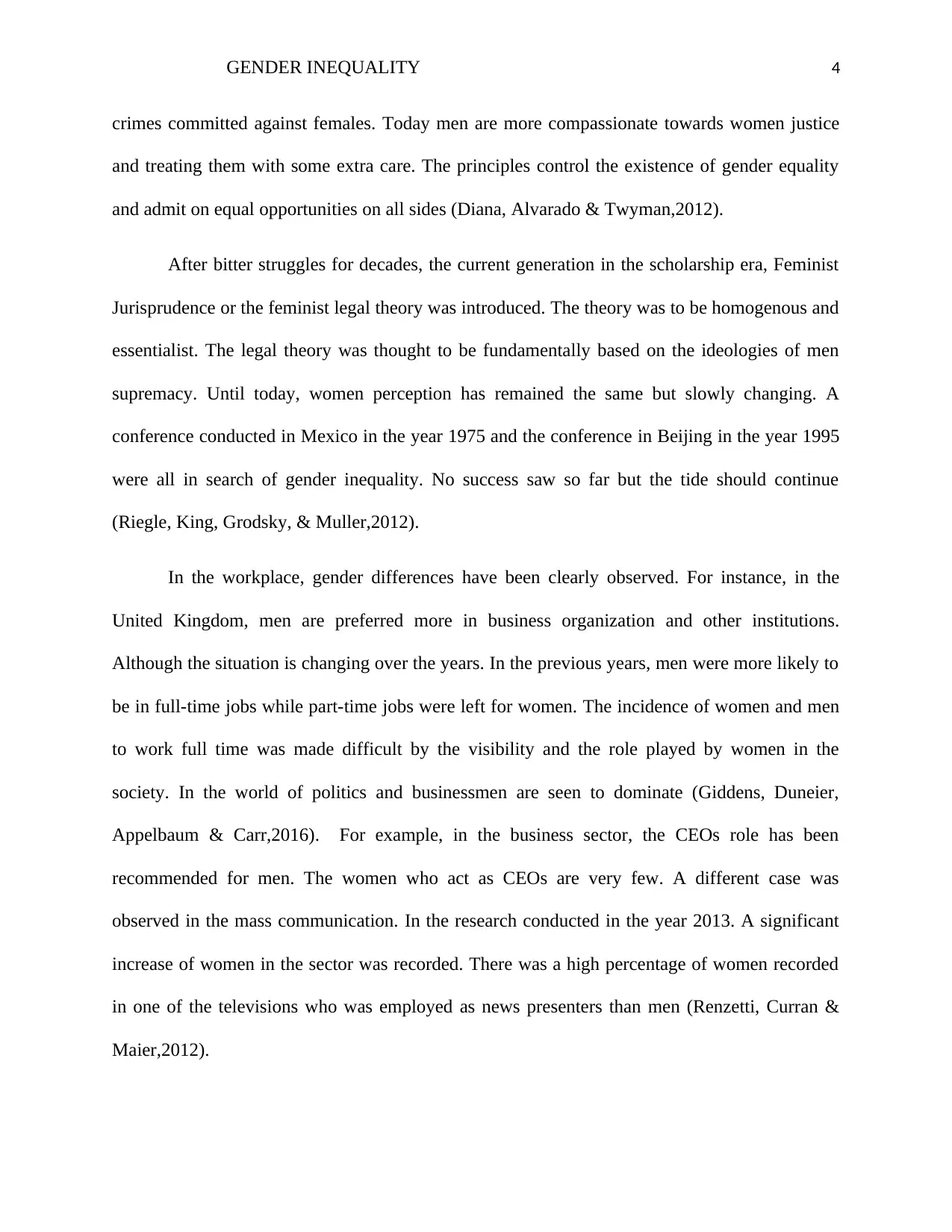
GENDER INEQUALITY 4
crimes committed against females. Today men are more compassionate towards women justice
and treating them with some extra care. The principles control the existence of gender equality
and admit on equal opportunities on all sides (Diana, Alvarado & Twyman,2012).
After bitter struggles for decades, the current generation in the scholarship era, Feminist
Jurisprudence or the feminist legal theory was introduced. The theory was to be homogenous and
essentialist. The legal theory was thought to be fundamentally based on the ideologies of men
supremacy. Until today, women perception has remained the same but slowly changing. A
conference conducted in Mexico in the year 1975 and the conference in Beijing in the year 1995
were all in search of gender inequality. No success saw so far but the tide should continue
(Riegle, King, Grodsky, & Muller,2012).
In the workplace, gender differences have been clearly observed. For instance, in the
United Kingdom, men are preferred more in business organization and other institutions.
Although the situation is changing over the years. In the previous years, men were more likely to
be in full-time jobs while part-time jobs were left for women. The incidence of women and men
to work full time was made difficult by the visibility and the role played by women in the
society. In the world of politics and businessmen are seen to dominate (Giddens, Duneier,
Appelbaum & Carr,2016). For example, in the business sector, the CEOs role has been
recommended for men. The women who act as CEOs are very few. A different case was
observed in the mass communication. In the research conducted in the year 2013. A significant
increase of women in the sector was recorded. There was a high percentage of women recorded
in one of the televisions who was employed as news presenters than men (Renzetti, Curran &
Maier,2012).
crimes committed against females. Today men are more compassionate towards women justice
and treating them with some extra care. The principles control the existence of gender equality
and admit on equal opportunities on all sides (Diana, Alvarado & Twyman,2012).
After bitter struggles for decades, the current generation in the scholarship era, Feminist
Jurisprudence or the feminist legal theory was introduced. The theory was to be homogenous and
essentialist. The legal theory was thought to be fundamentally based on the ideologies of men
supremacy. Until today, women perception has remained the same but slowly changing. A
conference conducted in Mexico in the year 1975 and the conference in Beijing in the year 1995
were all in search of gender inequality. No success saw so far but the tide should continue
(Riegle, King, Grodsky, & Muller,2012).
In the workplace, gender differences have been clearly observed. For instance, in the
United Kingdom, men are preferred more in business organization and other institutions.
Although the situation is changing over the years. In the previous years, men were more likely to
be in full-time jobs while part-time jobs were left for women. The incidence of women and men
to work full time was made difficult by the visibility and the role played by women in the
society. In the world of politics and businessmen are seen to dominate (Giddens, Duneier,
Appelbaum & Carr,2016). For example, in the business sector, the CEOs role has been
recommended for men. The women who act as CEOs are very few. A different case was
observed in the mass communication. In the research conducted in the year 2013. A significant
increase of women in the sector was recorded. There was a high percentage of women recorded
in one of the televisions who was employed as news presenters than men (Renzetti, Curran &
Maier,2012).
Paraphrase This Document
Need a fresh take? Get an instant paraphrase of this document with our AI Paraphraser
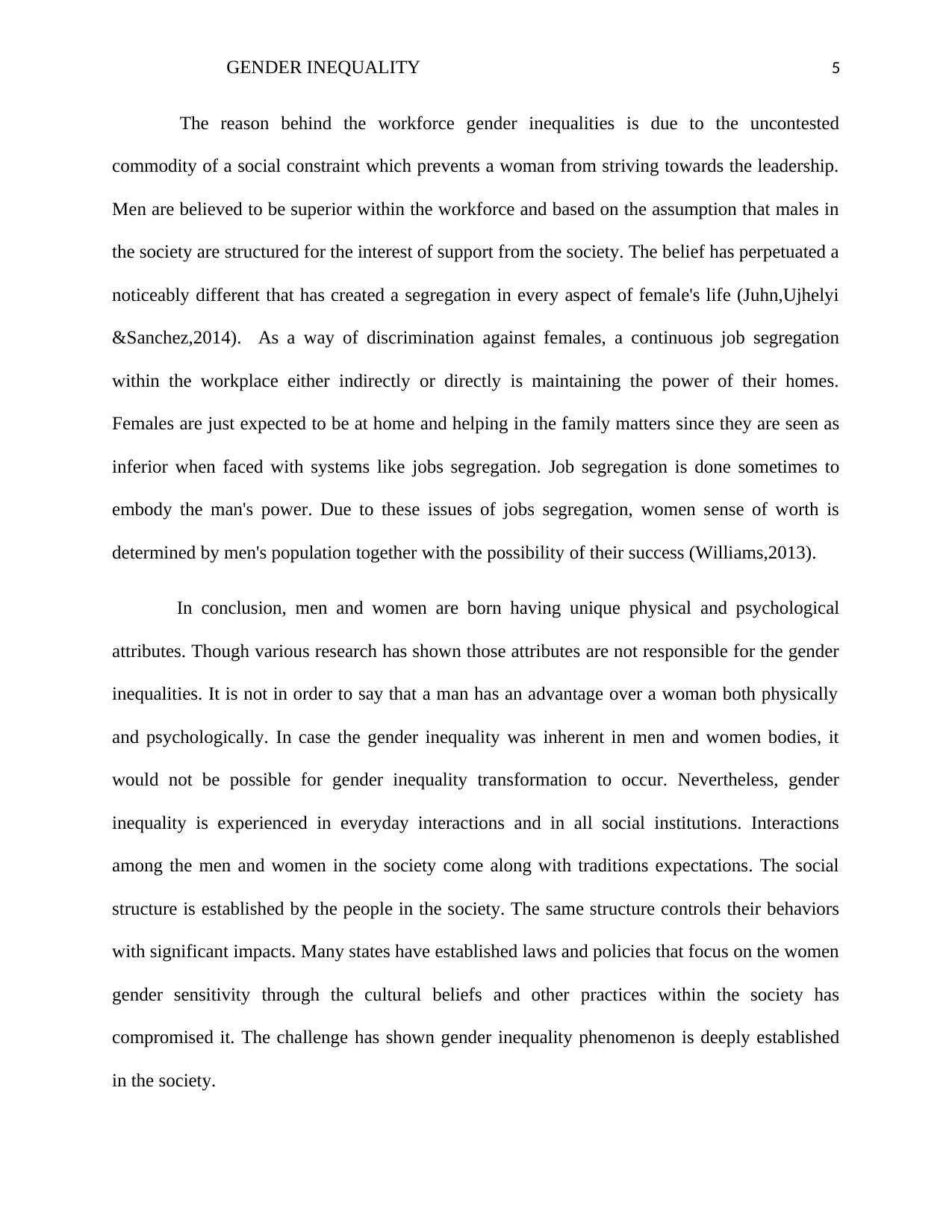
GENDER INEQUALITY 5
The reason behind the workforce gender inequalities is due to the uncontested
commodity of a social constraint which prevents a woman from striving towards the leadership.
Men are believed to be superior within the workforce and based on the assumption that males in
the society are structured for the interest of support from the society. The belief has perpetuated a
noticeably different that has created a segregation in every aspect of female's life (Juhn,Ujhelyi
&Sanchez,2014). As a way of discrimination against females, a continuous job segregation
within the workplace either indirectly or directly is maintaining the power of their homes.
Females are just expected to be at home and helping in the family matters since they are seen as
inferior when faced with systems like jobs segregation. Job segregation is done sometimes to
embody the man's power. Due to these issues of jobs segregation, women sense of worth is
determined by men's population together with the possibility of their success (Williams,2013).
In conclusion, men and women are born having unique physical and psychological
attributes. Though various research has shown those attributes are not responsible for the gender
inequalities. It is not in order to say that a man has an advantage over a woman both physically
and psychologically. In case the gender inequality was inherent in men and women bodies, it
would not be possible for gender inequality transformation to occur. Nevertheless, gender
inequality is experienced in everyday interactions and in all social institutions. Interactions
among the men and women in the society come along with traditions expectations. The social
structure is established by the people in the society. The same structure controls their behaviors
with significant impacts. Many states have established laws and policies that focus on the women
gender sensitivity through the cultural beliefs and other practices within the society has
compromised it. The challenge has shown gender inequality phenomenon is deeply established
in the society.
The reason behind the workforce gender inequalities is due to the uncontested
commodity of a social constraint which prevents a woman from striving towards the leadership.
Men are believed to be superior within the workforce and based on the assumption that males in
the society are structured for the interest of support from the society. The belief has perpetuated a
noticeably different that has created a segregation in every aspect of female's life (Juhn,Ujhelyi
&Sanchez,2014). As a way of discrimination against females, a continuous job segregation
within the workplace either indirectly or directly is maintaining the power of their homes.
Females are just expected to be at home and helping in the family matters since they are seen as
inferior when faced with systems like jobs segregation. Job segregation is done sometimes to
embody the man's power. Due to these issues of jobs segregation, women sense of worth is
determined by men's population together with the possibility of their success (Williams,2013).
In conclusion, men and women are born having unique physical and psychological
attributes. Though various research has shown those attributes are not responsible for the gender
inequalities. It is not in order to say that a man has an advantage over a woman both physically
and psychologically. In case the gender inequality was inherent in men and women bodies, it
would not be possible for gender inequality transformation to occur. Nevertheless, gender
inequality is experienced in everyday interactions and in all social institutions. Interactions
among the men and women in the society come along with traditions expectations. The social
structure is established by the people in the society. The same structure controls their behaviors
with significant impacts. Many states have established laws and policies that focus on the women
gender sensitivity through the cultural beliefs and other practices within the society has
compromised it. The challenge has shown gender inequality phenomenon is deeply established
in the society.
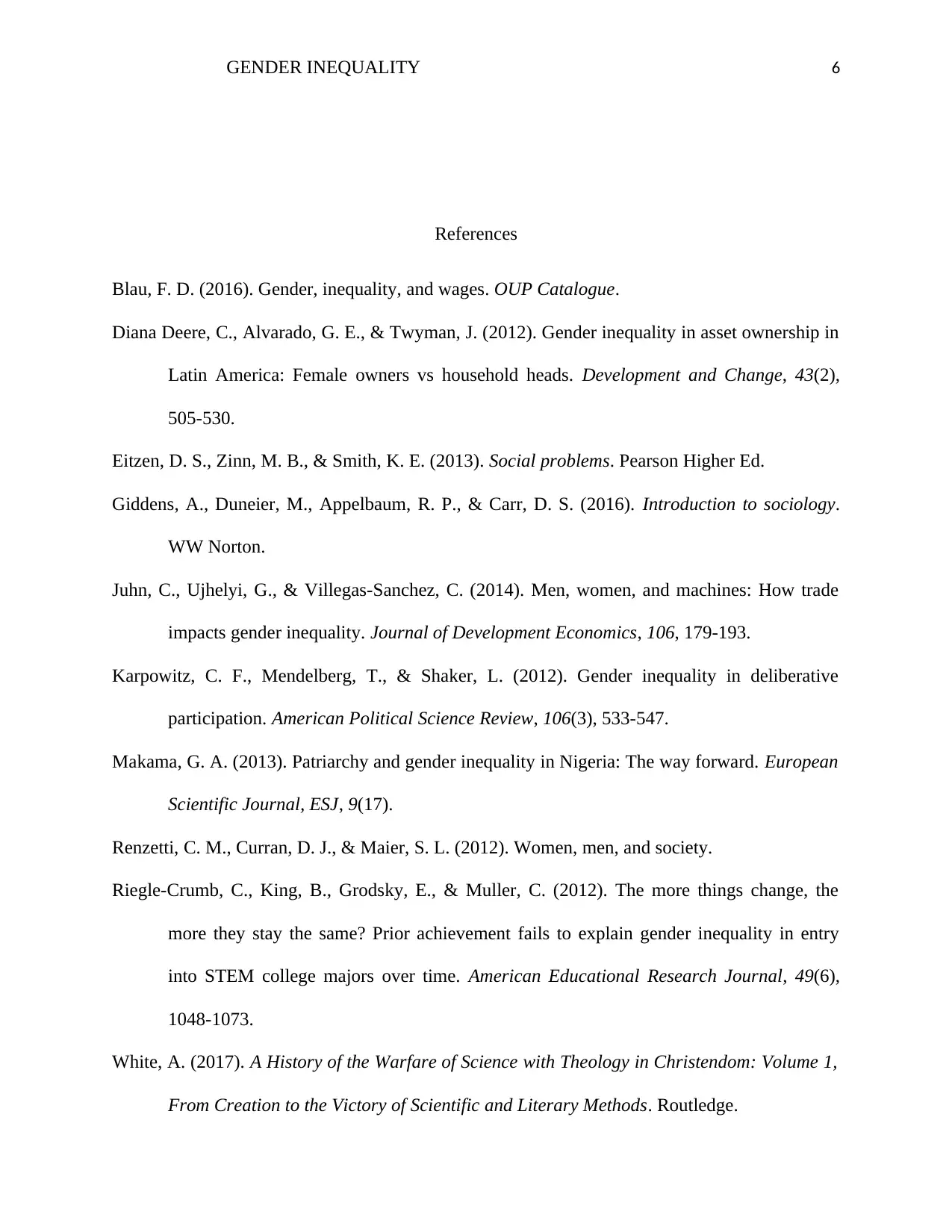
GENDER INEQUALITY 6
References
Blau, F. D. (2016). Gender, inequality, and wages. OUP Catalogue.
Diana Deere, C., Alvarado, G. E., & Twyman, J. (2012). Gender inequality in asset ownership in
Latin America: Female owners vs household heads. Development and Change, 43(2),
505-530.
Eitzen, D. S., Zinn, M. B., & Smith, K. E. (2013). Social problems. Pearson Higher Ed.
Giddens, A., Duneier, M., Appelbaum, R. P., & Carr, D. S. (2016). Introduction to sociology.
WW Norton.
Juhn, C., Ujhelyi, G., & Villegas-Sanchez, C. (2014). Men, women, and machines: How trade
impacts gender inequality. Journal of Development Economics, 106, 179-193.
Karpowitz, C. F., Mendelberg, T., & Shaker, L. (2012). Gender inequality in deliberative
participation. American Political Science Review, 106(3), 533-547.
Makama, G. A. (2013). Patriarchy and gender inequality in Nigeria: The way forward. European
Scientific Journal, ESJ, 9(17).
Renzetti, C. M., Curran, D. J., & Maier, S. L. (2012). Women, men, and society.
Riegle-Crumb, C., King, B., Grodsky, E., & Muller, C. (2012). The more things change, the
more they stay the same? Prior achievement fails to explain gender inequality in entry
into STEM college majors over time. American Educational Research Journal, 49(6),
1048-1073.
White, A. (2017). A History of the Warfare of Science with Theology in Christendom: Volume 1,
From Creation to the Victory of Scientific and Literary Methods. Routledge.
References
Blau, F. D. (2016). Gender, inequality, and wages. OUP Catalogue.
Diana Deere, C., Alvarado, G. E., & Twyman, J. (2012). Gender inequality in asset ownership in
Latin America: Female owners vs household heads. Development and Change, 43(2),
505-530.
Eitzen, D. S., Zinn, M. B., & Smith, K. E. (2013). Social problems. Pearson Higher Ed.
Giddens, A., Duneier, M., Appelbaum, R. P., & Carr, D. S. (2016). Introduction to sociology.
WW Norton.
Juhn, C., Ujhelyi, G., & Villegas-Sanchez, C. (2014). Men, women, and machines: How trade
impacts gender inequality. Journal of Development Economics, 106, 179-193.
Karpowitz, C. F., Mendelberg, T., & Shaker, L. (2012). Gender inequality in deliberative
participation. American Political Science Review, 106(3), 533-547.
Makama, G. A. (2013). Patriarchy and gender inequality in Nigeria: The way forward. European
Scientific Journal, ESJ, 9(17).
Renzetti, C. M., Curran, D. J., & Maier, S. L. (2012). Women, men, and society.
Riegle-Crumb, C., King, B., Grodsky, E., & Muller, C. (2012). The more things change, the
more they stay the same? Prior achievement fails to explain gender inequality in entry
into STEM college majors over time. American Educational Research Journal, 49(6),
1048-1073.
White, A. (2017). A History of the Warfare of Science with Theology in Christendom: Volume 1,
From Creation to the Victory of Scientific and Literary Methods. Routledge.
⊘ This is a preview!⊘
Do you want full access?
Subscribe today to unlock all pages.

Trusted by 1+ million students worldwide
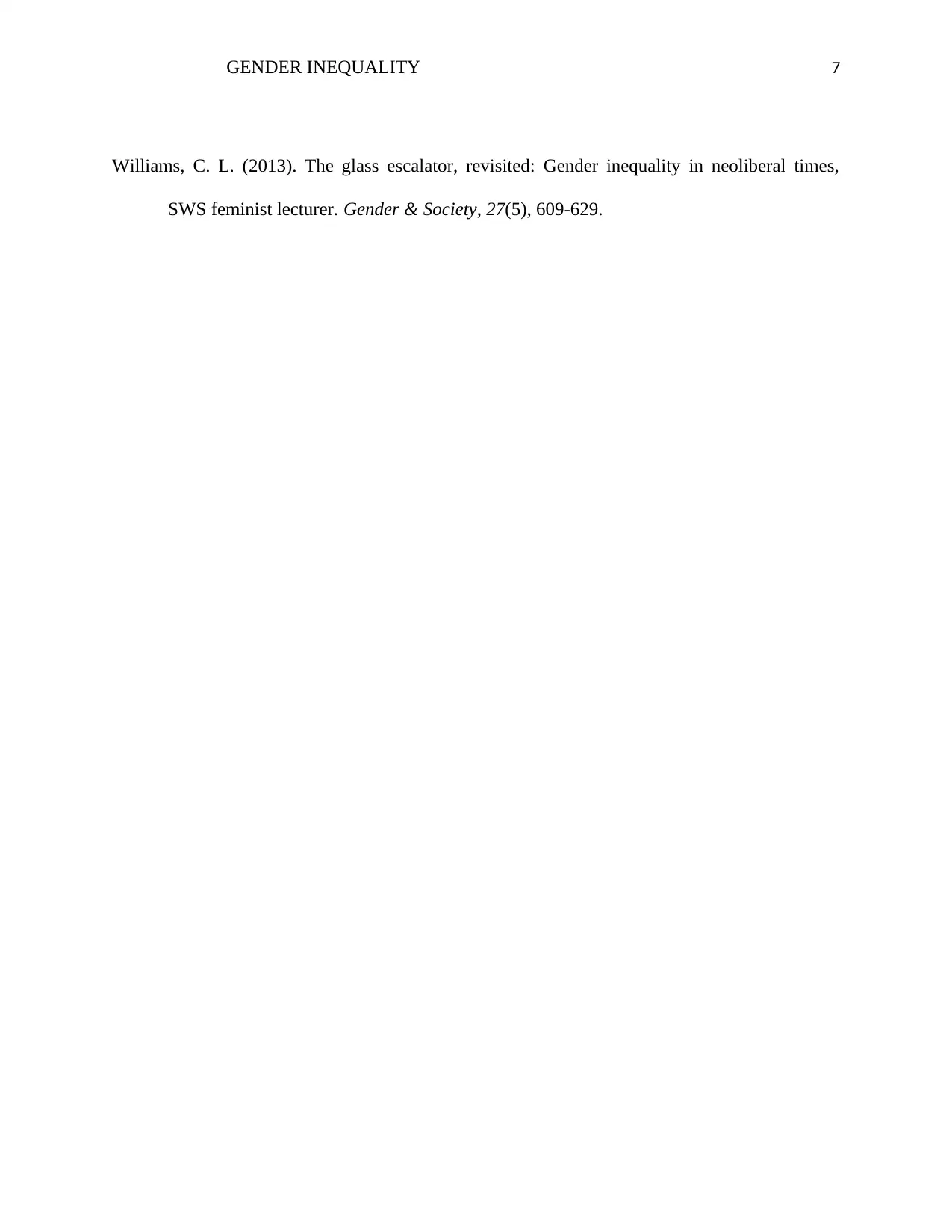
GENDER INEQUALITY 7
Williams, C. L. (2013). The glass escalator, revisited: Gender inequality in neoliberal times,
SWS feminist lecturer. Gender & Society, 27(5), 609-629.
Williams, C. L. (2013). The glass escalator, revisited: Gender inequality in neoliberal times,
SWS feminist lecturer. Gender & Society, 27(5), 609-629.
1 out of 7
Related Documents
Your All-in-One AI-Powered Toolkit for Academic Success.
+13062052269
info@desklib.com
Available 24*7 on WhatsApp / Email
![[object Object]](/_next/static/media/star-bottom.7253800d.svg)
Unlock your academic potential
Copyright © 2020–2025 A2Z Services. All Rights Reserved. Developed and managed by ZUCOL.





